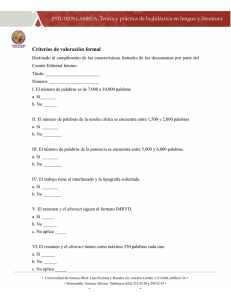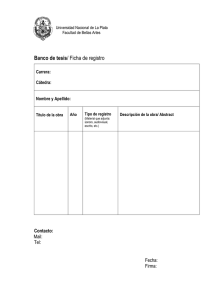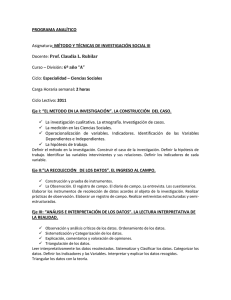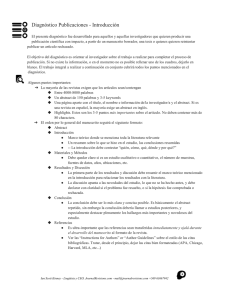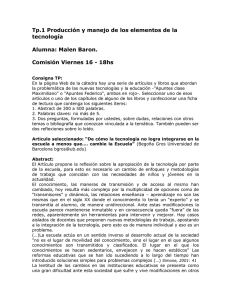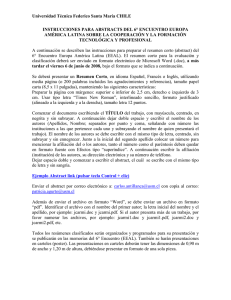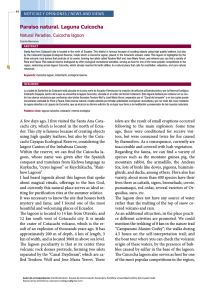Conectando el abstract con el texto
Anuncio
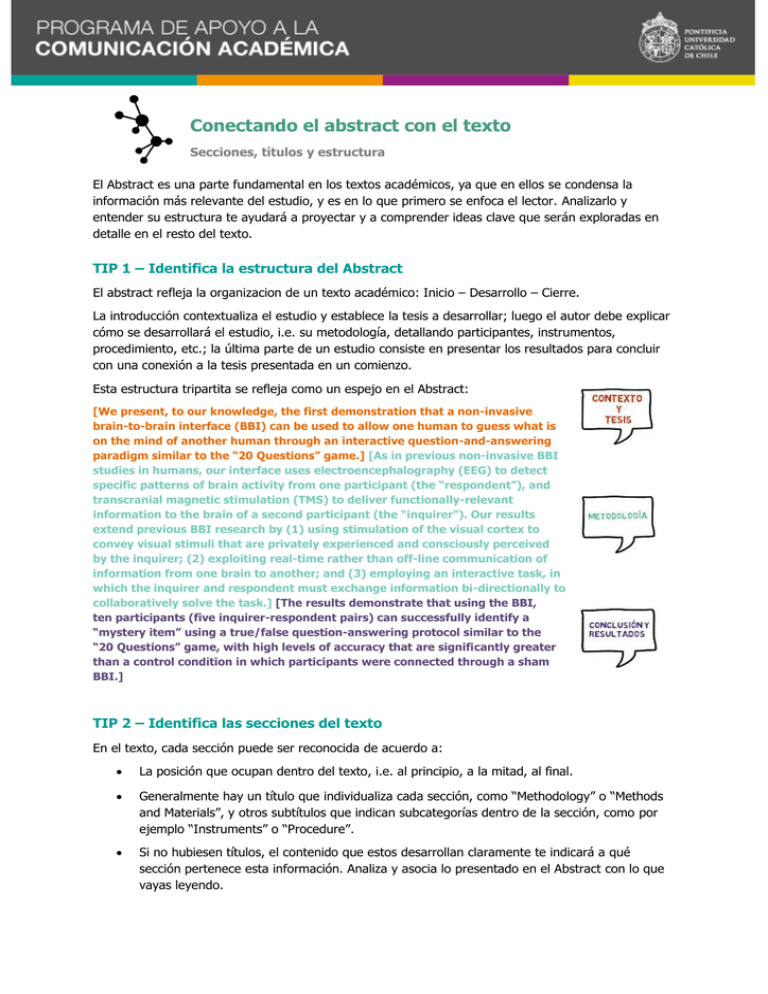
Conectando el abstract con el texto Secciones, títulos y estructura El Abstract es una parte fundamental en los textos académicos, ya que en ellos se condensa la información más relevante del estudio, y es en lo que primero se enfoca el lector. Analizarlo y entender su estructura te ayudará a proyectar y a comprender ideas clave que serán exploradas en detalle en el resto del texto. TIP 1 – Identifica la estructura del Abstract El abstract refleja la organizacion de un texto académico: Inicio – Desarrollo – Cierre. La introducción contextualiza el estudio y establece la tesis a desarrollar; luego el autor debe explicar cómo se desarrollará el estudio, i.e. su metodología, detallando participantes, instrumentos, procedimiento, etc.; la última parte de un estudio consiste en presentar los resultados para concluir con una conexión a la tesis presentada en un comienzo. Esta estructura tripartita se refleja como un espejo en el Abstract: [We present, to our knowledge, the first demonstration that a non-invasive brain-to-brain interface (BBI) can be used to allow one human to guess what is on the mind of another human through an interactive question-and-answering paradigm similar to the “20 Questions” game.] [As in previous non-invasive BBI studies in humans, our interface uses electroencephalography (EEG) to detect specific patterns of brain activity from one participant (the “respondent”), and transcranial magnetic stimulation (TMS) to deliver functionally-relevant information to the brain of a second participant (the “inquirer”). Our results extend previous BBI research by (1) using stimulation of the visual cortex to convey visual stimuli that are privately experienced and consciously perceived by the inquirer; (2) exploiting real-time rather than off-line communication of information from one brain to another; and (3) employing an interactive task, in which the inquirer and respondent must exchange information bi-directionally to collaboratively solve the task.] [The results demonstrate that using the BBI, ten participants (five inquirer-respondent pairs) can successfully identify a “mystery item” using a true/false question-answering protocol similar to the “20 Questions” game, with high levels of accuracy that are significantly greater than a control condition in which participants were connected through a sham BBI.] TIP 2 – Identifica las secciones del texto En el texto, cada sección puede ser reconocida de acuerdo a: La posición que ocupan dentro del texto, i.e. al principio, a la mitad, al final. Generalmente hay un título que individualiza cada sección, como “Methodology” o “Methods and Materials”, y otros subtítulos que indican subcategorías dentro de la sección, como por ejemplo “Instruments” o “Procedure”. Si no hubiesen títulos, el contenido que estos desarrollan claramente te indicará a qué sección pertenece esta información. Analiza y asocia lo presentado en el Abstract con lo que vayas leyendo. TIP 3 – Identifica Palabras Clave en el Abstract y Conecta con el Texto Las palabras, términos, siglas, ideas y conceptos presentados en el Abstract serán repetidos a lo largo del texto. Identifica en el Abstract no solo la estructura, sino también qué palabras clave irán asociadas a cada sección. En los siguientes ejemplos se puede apreciar cómo se repiten los mismos conceptos en el Abstract y en las secciones del texto Ejemplo 1 Introducción [primera parte del abstract] We present, to our knowledge, the first demonstration that a non-invasive brain-to-brain interface (BBI) can be used to allow one human to guess what is on the mind of another human through an interactive question-and-answering paradigm similar to the 20 questions game. Introducción [extracto del tercer párrafo del paper] We report results from a new experiment that overcomes the limitations of these previous studies by increasing both the complexity of the tasks preformed with a non-invasive BBI in humans, and the quantity of information transferred between two brains. In our experiment, five pairs of participants played a shortened version of the popular 20 questions parlor game, in which a participant can ask up to 20 yes/no questions in to figure out what object a second participant is thinking of. We chose this paradigm because it presents several important features that test the utility of a BBI, including the fact that (…) Ejemplo 2 Conclusiones [ultima parte del abstract] The results demonstrate that using the BBI, ten participants (five inquirer-respondent pairs) can successfully identify a “mystery item” using a true/false question-answering protocol similar to the “20 questions” game, with high levels of accuracy that are significantly greater than a control condition in which participants were connected through a sham BBI. Conclusiones [extracto del primer párrafo de la sección] This paper represents the successful demonstration of a new, non-invasive BBI in humans, which allowed pairs of participants to successfully collaborate and complete a series of question-andanswer games using information transferred between their brains. This BBI paradigm significantly extends and improves previous protocols in that (1) it involves the transfer of consciously perceived information in the form of phosphenes. (2) works in real-time and (3) permits bidirectional information exchange between two participants. In this sense, this experiment represents a (…) TIP 4 – Analiza, Comprende e Interpreta Conceptos y Oraciones Clave Al identificar palabras o frases centrales en el abstract y el texto, el siguiente paso es analizar, comprender e interpretar estos conceptos. Aplicar este consejo te ayudará a agilizar el proceso de lectura, ya que podrás comprender las relaciones entre las ideas sin detenerte a buscar en el diccionario o atrás en la lectura el significado de palabras que ya revisaste y comprendiste anteriormente. En el siguiente ejemplo te mostraremos algunas interpretaciones de frases: (…) In this analysis, the signal (or in classification terms, the label) is the true response to each question, and the prediction (or the class) is the inquirers understanding of the respondents answer/ The performance of each pair can then be described using receiver operating characteristic (roc) analysis (…) REVISIÓN En este recurso te hemos mostrado que: La estructura del abstract refleja la organización del texto, por lo tanto identificarla al leer el Abstract es muy importante Es posible reconocer las secciones del texto por medio de elementos como subtítulos, posición y contenido Hay palabras claves en el abstract que se repiten en cada sección y que necesitan análisis, comprensión e interpretación cuando leas el Abstract, para que se aliviane la carga de comprensión al avanzar en la lectura del resto del texto. Autor Francisca Leal P. Docente Facultad de Letras Colaboradores Gustavo Palma Paula Miranda Kathleen Curtis Tutor PRAC Inglés Esta obra está licenciada bajo la Licencia Creative Commons Atribución-NoComercial- SinDerivar 4.0Internacional. Para ver una copia de esta licencia, visita http://creativecommons.org/licenses/by-ncnd/4.0/
